daftar nama situs slot terpercaya
Huawei Cloud provides convenient, secure, and premium cloud services to help enterprises address new challenges on the digital transformation journey.

Cloud native brings new value to various industries and is essential for enterprise digital transformation. While many enterprises are currently migrating their applications to cloud, as part of a new application-centric cloud transformation, some remain reluctant or unsure about how to migrate to the cloud, leaving them unable to fully utilize its benefits. This is because cloud services have been resource-centric over the past decade, focusing more on infrastructures like compute, storage, and networks.
As digital transformation advances, cloud has been used across more areas in greater depth. Enterprises have started rethinking how to apply digital technologies to change business applications and transform customer experience, operating efficiency, and business models. This is driving cloud to become application-centric, and promoting the innovation and evolution of overall cloud technical architecture.
Cloud native unlocks new value
In cloud computing, cloud native is becoming essential for enterprise transformation and upgrade, as it creates new value for various industries. Cloud native is empowering emerging enterprises and traditional industries, such as financial services, automotive, manufacturing, and ports, to improve business efficiency, accelerate business innovation, and boost value.
Finance
The finance industry, which has extremely strict data-security requirements, encountered bottlenecks in developing its traditional business model. Eliminating concerns about public cloud security prompted banks to start building reliable platforms with systematic security protection provided by cloud vendors, covering technologies, personnel, operations, and processes. These platforms possess fully-integrated, cloud-native capabilities such as resource elasticity, agile innovation, and high concurrency. In Thailand, the system enabled one century-old bank to develop a new service for digital growth. It gained 45,000 online customers within three months of launch and developed a credit line of 204 million baht (approx. US$5.9 million). Thanks to automatic, data-driven processes, a large number of loan services could be approved in just five minutes, doubling transaction performance over traditional loan services.
Automotive
The automotive industry is in the middle of an enormous transformation characterized by rapidly growing data. By leveraging elastic cloud-native infrastructure resources, an automaker has been able to allocate more computing power during peak daytime hours of connected vehicle services and reduce computing power at night, thus reducing costs by more than 40%. More importantly, the automaker has used cloud-based data and AI analytics technologies to better understand driving behaviors, resulting in many innovative services such as smart stores, smart after-sales, and intelligent manufacturing. Car sales are expected to at least double in 2022.
Manufacturing
The supply chain system is the key to success in the manufacturing industry, but comes with serious systemic risks. Enterprises must make their supply chain operations more intelligent by using scenario-based algorithm models that streamline all links between suppliers and customers and building a high-quality data foundation. Intelligent supply chain operations allow enterprises to develop optimal supply resource configurations, while considering a range of variables such as demand, order, inventory, logistics, production capacity, and external environment. This enables enterprises to complete scenario-based, supply-demand simulation within minutes, shorten planning from weeks to days, and agilely cope with uncertainties.
Ports
The port industry faces many challenges in terms of talent and technology as it undergoes digital transformation. A port operator have developed a platform + operation transformation path by fully migrating to public cloud. This has allowed the platforms to accumulate successful experience and data to drive continuous business operations. the port operator have streamlined the data of ports, logistics, the industrial sector, and ecosystem partners. It has also built and rolled out the global digital supply network (business foundation) and OCC digital operation platform (operation foundation). On this basis, the port operator has developed many innovative applications through the application of convenient development tools on the cloud. On the way to full digitalization, these applications have shortened container circulation time at the port by 13% and reduced the time needed for sea-rail combined transportation by a full day.
Emerging enterprises
Emerging enterprises are full of ideas about future development, which is in turn creating surging requirements. Through cloud-native and microservice transformation, all their resources are hosted by cloud vendors. This enables the second-level scaling capabilities of cloud native and allows these enterprises to handle fluctuations in service development and focus on core business innovation.
These examples show that an increasing number of enterprises care about more than just the cost of cloud. They are now interested in using it to drive developments in the new era by deeply integrating scenario-based applications with cloud, and data and AI on cloud. They have also gained a broader understanding of the value of cloud with the new value being created by cloud driving the cloud industry to new heights (as shown in Figure 1).

Figure 1: Cloud native value
Gartner predicts that more than 95% of new digital projects will use cloud-native platforms by 2025, positioning these platforms as a must to dive deep into digitalization. However, digital transformation is still challenging for the majority of enterprises. It requires a combination of technologies, including all-element data connection, security protection, intelligent decision-making and operations, and knowledge and experience about digital transformation. To support the successful transformation of every enterprise into new cloud-native enterprises, Huawei proposed the Cloud Native 2.0 concept in 2020 (as shown in Figure 2). Cloud Native 2.0 realizes continuous innovation in three areas and provides users with an upgraded cloud-native experience from multiple dimensions.
In terms of Infrastructure as a Service, Huawei Cloud has deployed 29 Regions and 78 availability zones (AZs) that cover more than 170 countries and regions. It has also built global cloud infrastructure with a unified architecture, providing infrastructure services like compute, storage, network, and security and quickly delivering a premium cloud experience with just 50 ms latency worldwide.
In terms of Technology as a Service, Huawei Cloud keeps innovating to make breakthroughs in fundamental technologies, and builds the most simplified and most easy-to-use tools for developers, realizing easily-accessible innovation. DevCloud integrates the multiple production pipeline capabilities of Huawei Cloud to support collaborative development and the on-demand orchestration of data, AI models, and digital content. It also allows application developers, data engineers, and AI scientists to work on the same platform and share R&D capabilities and assets, improving multi-team collaboration efficiency and achieving faster application modernization.
In terms of Expertise as a Service, Huawei Cloud enables digital transformation across industries. Working with 41,000 partners and over four million developers, we provide the best practices of Huawei and global customers and partners, delivering services for customers via more than 100,000 APIs.
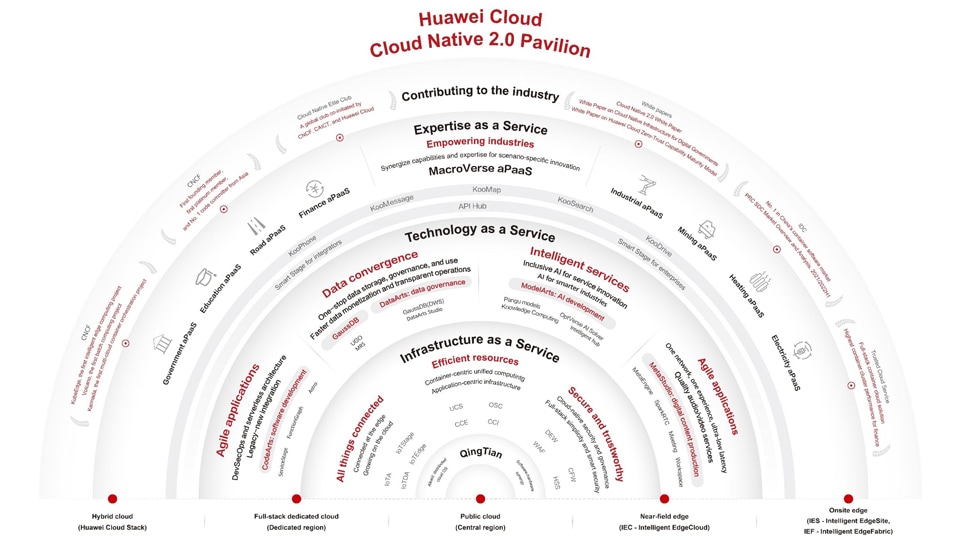
Figure 2: Cloud Native 2.0 panorama
To make it easier and more convenient for customers to use the latest cloud services, we have made numerous innovations and breakthroughs across many technologies, including those related to compute, applications, data analysis, artificial intelligence, and security, to form a systematic technical architecture (as shown in Figure 3). This section will explain KooVerse, security zones, and data and AI convergence in detail.
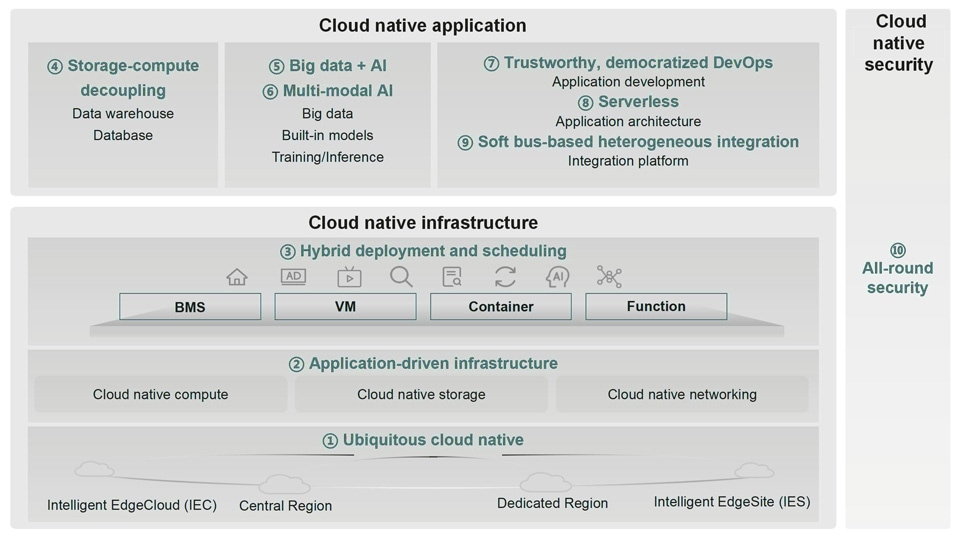
Figure 3: Key Cloud Native 2.0 technologies
KooVerse is a distributed cloud infrastructure with unified architecture that covers the entire world. It provides customers compute, storage, and network infrastructure services and delivers a consistent global experience. Huawei Cloud KooVerse delivers a 50-ms user experience through CloudOcean, CloudSea, and CloudLake (as shown in Figure 4), thus meeting the differing latency requirements of enterprise services. CloudLake edge access provides an ultra-low cloud-to-device latency of 5 ms, allowing it to meet the requirements of hot applications that require ultra-low latency in, for example, manufacturing and autonomous driving scenarios, with a maximum of 5,000 servers. CloudSea regional center offers a latency of less than 10 ms for about 100,000 servers. The million-node CloudOcean global center, which is set to be deployed in China's Guizhou, Inner Mongolia, and Anhui, can provide customers with cloud resources that have a latency of 50 ms. By combining tech with local geographical advantages, we provide our customers with greener, more efficient cloud services that can meet requirements for massive computing power in the future digital economy.
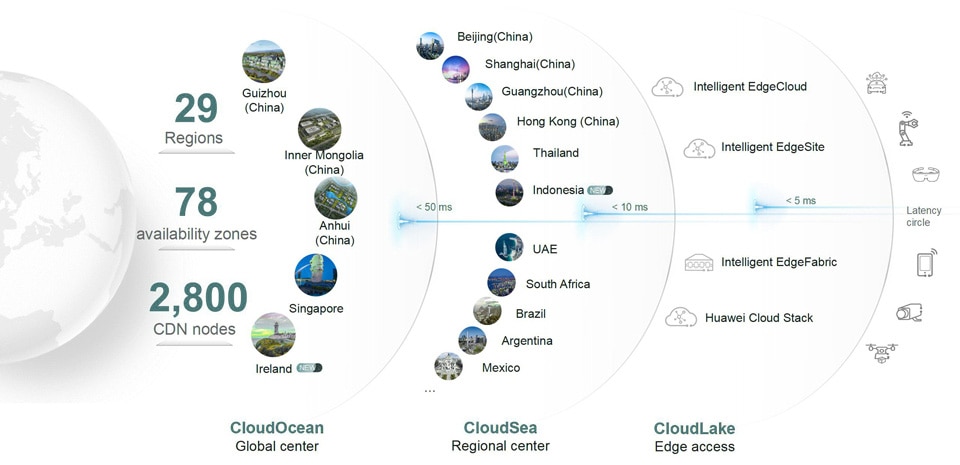
Figure 4: Huawei Cloud KooVerse
Focusing on data protection, Huawei Cloud provides a highly reliable, autonomous, and intelligent cloud security protection and O&M system. Cloud Security Brain identifies and resolves security risks, threats, and attacks in near-real time, creating a cloud platform that offers customers greater security than local data centers, enabling them to migrate their services to cloud worry-free. To meet security requirements related to the migration of different enterprise services and data to the cloud, we provide customers with dedicated security zones at four security levels, as shown in Figure 5. The S1 dedicated zone provides public cloud users with a full range of security services, including host security, network security, application security, data security, and managed security services, meeting enterprises' requirements for secure cloudification. On the basis of the S1 zone, the S2 zone provides cloud resources that meet the security and compliance requirements of multiple industries such as government, finance, and automotive. The S3 zone provides dedicated physical isolation resources and dedicated O&M zone services for customers. The S4 zone provides customers with higher-level physical isolation and has specified requirements for maintenance personnel. This enables customers to fully control identity and permission, resource ownership, and data usage.

Figure 5: Dedicated security zones
Streamlining data governance and AI development is the key to realizing data value and data-driven operations. Huawei Cloud converges DataArts and ModelArts to provide customers with cost-effective, easy-to-use data solutions (as shown in Figure 6).
- Decoupled storage and compute architecture based on cloud native. The three-layer decoupled architecture of cloud storage, caching, and compute is highly cost-effective and offers flexible compute. Cloud storage is a large storage pool, where resources are fully shared between multiple tenants. This reduces cost per unit, and allows users to store all historical data and respond to unpredictable analysis requirements. Remote storage enables elastic scaling and on-demand, separate use of compute and storage resources. Caching is used to compensate for performance losses caused by remote storage, keeping losses within a small range that is imperceptible to services.
- Unified metadata enables innovation on the data and AI convergence platform. The platform connects the data silos of big data, data warehouses, and AI, and consolidates capabilities like data catalogs, data permissions, and multi-version management into a single point, where data can be accessed. In this way, data usage is not restricted by isolated systems, such as when the same table is analyzed by different analysis engines. The same table can be used across data warehouse, big data, and machine learning tasks. Different users do not need to move data back and forth between dedicated systems, regardless of the engines they use to process data.
- AI for Data: Our AI-assisted, one-stop data governance platform supports one-click integration of over 40 heterogeneous data sources and various Huawei Cloud basic data services. The platform can govern data development and provide quality assurance throughout the data lifecycle, accumulate model assets, and build industry knowledge bases. Data for AI: A unified data and AI development environment allows different roles to take advantage of their own strengths and meet their goals. For example, data engineers can use familiar tools to invoke AI capabilities, facilitating collaboration between big data and AI development.
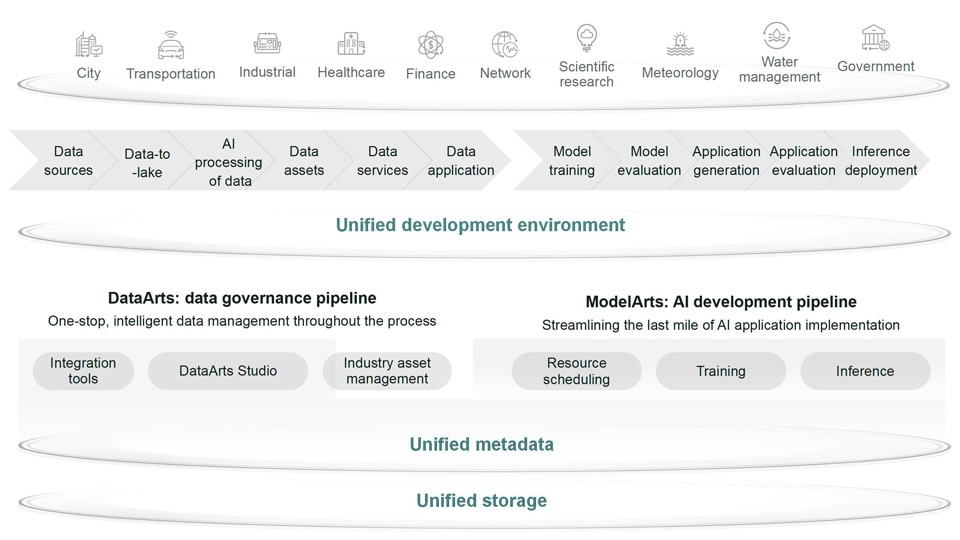
Figure 6: Data and AI convergence
Huawei has opened up its cumulative technology expertise in cloud, network, edge, device, and chip to global customers and partners in the form of cloud services, lowering the threshold for customers to use digital technologies and accelerate innovation.

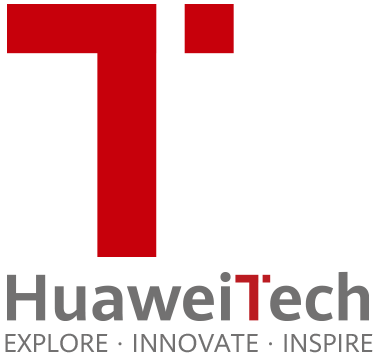

Cloud will play a fundamental role in shaping the intelligent world.